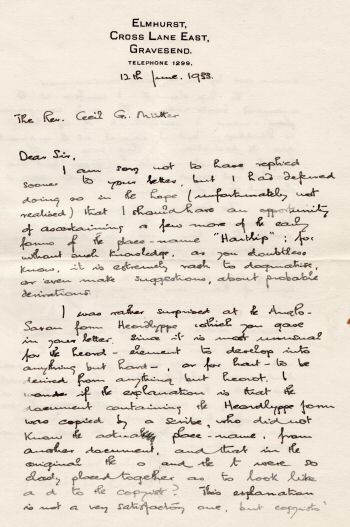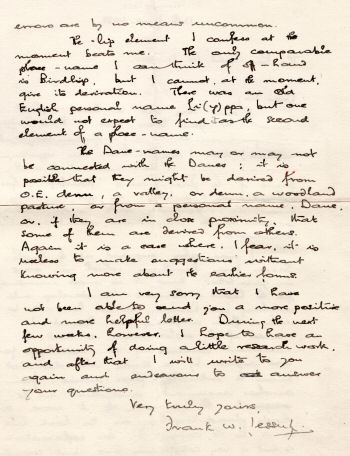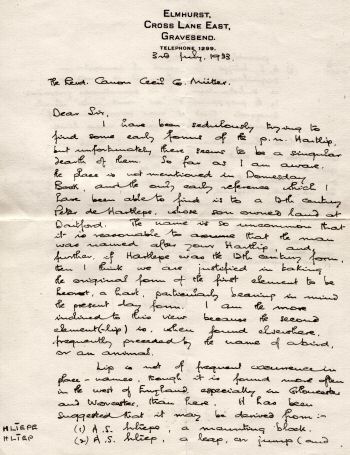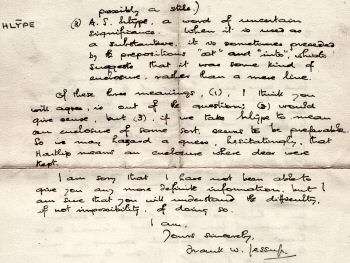
The meaning of the word "Hartlip" .... part 1
The usual explanation of the meaning of the word Hartlip concerns deer jumping. The version given, for example, in Wikipedia, is as follows.
"The name Hartlip derives from the Old English hliep, which meant a gate or fence. In combination with heorot (hart or stag), the name therefore means a gate over which harts leap."

This is the interpretation of Hartlip that has been incorporated into the school badge and logo of Hartlip's primary school - as shown on the right.
However, this is not the only explanation. In his book The Place Names of Kent, J. K Wallenberg proposes a more earthy meaning. He interprets the Old English hart and hlype to mean "leaping place, or place where deer copulate.”
In 1933 the Rev. Canon Mutter, Vicar of Hartlip, received two letters from Frank W. Jessup. These two letters were found in a bundle of papers in the Church. Canon Mutter was interested in local history and seems to have written to Jessup, an expert in Kentish history, about various place names in the Hartlip area. It seems that, in the first letter that Canon Mutter wrote to Mr. Jessup, he had told him that the first record of the name Hartlip was as Heordlyppe. Also he seems to have enquired about the derivation of the word "Dane", presumably in reference to Dane Lane and Dane House. The replies from Jessup are shown on the right, with transcriptions on the left.
First reply from Jessup
12th June 1933
The Rev. Cecil G Mütter
Dear Sir,
I am sorry not to have replied sooner to your letter, but I had deferred doing so in the hope (unfortunately not realised) that I should have an opportunity of ascertaining a few more of the early forms of the place-name "Hartlip": for without such knowledge, as you doubtless know, it is extremely rash to dogmatise, or even make suggestions, about probable derivations.
I was rather surprised at the Anglo-Saxon form Heordlyppe, which you gave in your letter. Since it is most unusual for the heord- element to develop into anything but hard-, or for hart- to be derived from anything but heorot I wonder if the explanation is that the document containing the Heordlyppe form was copied by a scribe, who did not know the actually place name, from another document, and that in the original the o and the t were so closely placed together as to look like a d to the copyist. This explanation is not a very satisfactory one, but copyists’ errors are by no means uncommon.
The –lip element I confess at the moment beats me. The only comparable place-name I can think of off-hand is Birdlip, but I cannot, at the moment, gives its derivation. There was an Old English personal name Li(y)ppa, but one would not expect to find it as the second element of a place-name.
The Dane-names may or may not be connected with the Danes: it is possible that they might be derived from O.E. denu, a valley, or denn a woodland pasture, or from a personal name, Dane, or, if they are in close proximity, that some of them are derived from others. Again it is a case where, I fear, it is useless to make suggestions without knowing more about the earlier forms.
I am very sorry that I have not been able to send you a more positive and more helpful letter. During the next few weeks, however, I hope to have an opportunity of doing a little research work, and after that I will write to you again and endeavour to answer your questions.
Very truly yours
Frank W. Jessup

Second reply from Jessup
3rd July 1933
The Rev. Canon Cecil G Mütter
Dear Sir,
I have been sedulously trying to find some early forms of the p.n. Hartlip, but unfortunately there seems to be a singular dearth of them. So far as I am aware, the place is not mentioned in Domesday Book, and the only early reference which I have been able to find is to a 12th century Peter de Hartlepe, whose son owned land at Dartford. The name is so uncommon that it is reasonable to assume that the man was named after your Hartlip, and, further, if Hartlepe was the 12th century form, then I think we are justified in taking the original form of the first element to be heorot, a hart, particularly bearing in mind the present day form. I am more inclined to the view because the second element (-lip) is, when found elsewhere, frequently preceded by the name of a bird, or an animal.
Lip is not of frequent occurrence in place-names, though it is found more often in the west of England, especially in Gloucester and Worcester, than here.
It has been suggested that it may be derived from
(1) A.S. hliepe, a mounting block
(2) A.S. hliep, a leap or jump (and possibly a stile.)
(3) A.S. hlype, a word of uncertain significance.
When it is used as a substantive, it is sometimes preceded by the prepositions "out" and "into", which suggests that it was some kind of enclosure, rather than a mere line.
Of these three meanings, (1), I think you will agree, is out of the question; (2) would give sense, but (3), if we take hlype to mean an enclosure of some sort, seems to be preferable.
So we may hazard a guess, hesitatingly, that Hartlip means an enclosure where deer were kept.
I am sorry that I have not been able to give you any more definite information, but I am sure that you will understand the difficulty, if not impossibility, of doing so.
I am,
Yours sincerely
Frank W. Jessup



